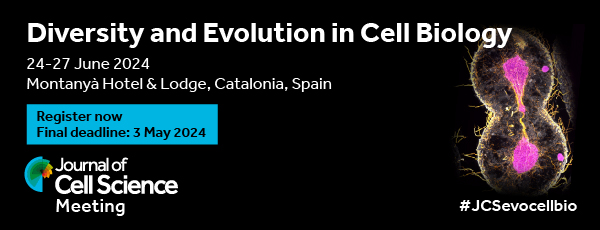Issues
-
Cover image
Cover Image

Cover: A complex set of cellular mechanisms regulates the balance between healthy muscle tissue (red, left) and muscles in which a loss of muscle maintenance causes tissuedegeneration (right). See article by N. Green et al. (jcs217943).
- PDF Icon PDF LinkTable of contents
- PDF Icon PDF LinkIssue info
RESEARCH HIGHLIGHTS
FIRST PERSON
REVIEWS
Mechanical forces in cell monolayers
Summary: The transmission of mechanical signals through cellular assemblies regulates collective cell behavior.
Unite to divide – how models and biological experimentation have come together to reveal mechanisms of cytokinesis
Summary: Biological experimentation and modeling have advanced our understanding of various cell behaviors. We provide a primer for biologists on several modeling strategies and highlight how modeling has revealed cytokinetic mechanisms.
Glycosphingolipid metabolism in cell fate specification
Summary: Glycosphingolipids are emerging as powerful determinants in differentiation events. Here, we review the existing literature on the role of glycosphingolipids in cell fate determination.
RESEARCH ARTICLES
FLCN is a novel Rab11A-interacting protein that is involved in the Rab11A-mediated recycling transport
Summary: FLCN regulates the Rab11A-mediated recycling transport pathway.
A tissue communication network coordinating innate immune response during muscle stress
Summary: Activation of Drosophila innate immune responses is coordinated at local and systemic levels through tissue crosstalk following disruptions to muscle homeostasis.
Direct binding of Talin to Rap1 is required for cell–ECM adhesion in Drosophila
Summary: The small GTPase Rap1 binds directly to the F0 domain of Talin allowing its recruitment to integrins at the plasma membrane. This process appears to be strictly required for integrin-mediated adhesion in Drosophila.
Gli2 modulates cell cycle re-entry through autophagy-mediated regulation of the length of primary cilia
Summary: Gli2 knockout in fibroblasts lengthens primary cilia through enhanced autophagy-mediated Ofd1 degradation. This ciliary lengthening delays cell cycle re-entry – an unexpected mechanism for cell cycle regulation.
ADAR2-mediated Q/R editing of GluK2 regulates kainate receptor upscaling in response to suppression of synaptic activity
Highlighted Article: Synaptic suppression promotes proteasomal degradation of the mRNA-editing enzyme ADAR2. Decreased ADAR2 levels reduce Q/R editing of the kainate receptor subunit GluK2 leading to enhanced surface expression and homeostatic upscaling of GluK2-containing KARs.
Lack of G1/S control destabilizes the yeast genome via replication stress-induced DSBs and illegitimate recombination
Summary: Absence of G1/S control in the budding yeast swi6Δ mutant leads to cell death due to replication stress and subsequent DSBs. Rad51 helps to repair breaks, but causes DNA rearrangements.
SHP-2 is activated in response to force on E-cadherin and dephosphorylates vinculin Y822
Summary: Here, we employ a novel technique to manipulate phosphatases, revealing a mechanism for how force transmission is switched off or reset.
Bexarotene – a novel modulator of AURKA and the primary cilium in VHL-deficient cells
Highlighted Article: An image-based screen using a dual labeling strategy identified bexarotene, a rexinoid, as a novel modulator of the primary cilium in VHL-deficient cells.
Cullin-3–KCTD10-mediated CEP97 degradation promotes primary cilium formation
Highlighted Article: CEP97 degradation mediated by the CUL3–RBX1–KCTD10 E3 ubiquitin ligase is crucial for serum-starvation-induced CP110 removal and ciliogenesis.
An interaction network between the SNARE VAMP7 and Rab GTPases within a ciliary membrane-targeting complex
Summary: Two Rab proteins and a Rab GEF provide a ‘cradle’ for the longin SNARE VAMP7 mediating its incorporation into prebudding complex at the Golgi/TGN during sensory receptor ciliary trafficking.
PREPRINT HIGHLIGHTS
Introducing our new Editors

We welcome three new Editors to Journal of Cell Science - Robert Parton, Richa Rikhy and Simon Cook. You can read more about them in the Editorial from our Editor-in-Chief Michael Way.
2024 Journal Meeting 'Diversity and Evolution in Cell Biology'

Registration is open for our 2024 Journal Meeting Diversity and Evolution in Cell Biology, which aims to bring together evolutionary biologists and cell biologists investigating diverse aspects of cellular physiology. Final registration deadline: 3 May 2024.
Workshop: Physics of the Early Embryonic Cell Divisions

Early-career researchers interested in the roles of nuclear lipids, apply now for one of the ten funded places at this Workshop, which will take place 11-14 November 2024. Application deadline: 17 May.
Reasons to submit to Journal of Cell Science

There are many benefits to publishing in Journal of Cell Science - read more about why you should choose JCS or visit our submission page now.
Propose a new Workshop for 2026

We are now accepting proposals for our 2026 Workshops programme. We aim to be responsive to the community and open to novel initiatives, so if you have a new idea for a biological workshop that you feel would work well, please apply. Applications deadline: 19 July 2024.



